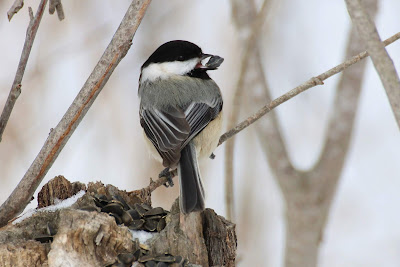Black-capped Chickadees
I often mumble to myself about all of the Chickadee photos that I take, but I can't help myself as they are so cute. I was recently asked by Lambton Wildlife to do a species presentation on any vertebrate of my choosing. While scrolling through my photo files, I realized that I now had a use for all those Chickadee pictures!
During the winter months, chickadees eat enough food daily to equal their body weight, and spend almost all of their waking hours looking for food.
One Chickadee weighs 11-12 grams, the equivalent of 5 pennies!
Chickadees develop a pecking order around food, and younger birds need to wait for their elders to eat first.
Black-capped Chickadees are able to increase the size of their brains by 30% in the winter, allowing them to remember a thousand hiding spots for their cached seeds. I have watched many a seed be tucked into tree bark by this species. Brain size returns to normal in the spring when they no longer need the extra memory space.
Nests are excavated by both adults in decaying stumps. The nest is about 21 cm deep. Bark and moss is often used for the foundation and animal fur, feathers, or man made materials are used as a lining.
The number of eggs can range from 1 to over 10. Incubation lasts 12-13 days and the hatched chicks stay in the nest for another 12-16 days before venturing out into the world.
The oldest known banded bird lived to be 12 years, 5 months.
The average age of a wild bird is 2.5 years.
Insects make up 70% of their food. Chickadees provide an excellent form of natural pest control eating insect eggs and larva. They apparently have a particular fondness for ants.
Adult Males can be identified as they have a larger black bib than the female. In my experience, Chickadees are so active, that I have not learned to recognize the difference in bib size.
If you ever have the chance to hand feed chickadees, I highly recommend it!
Experiencing "that chickadee feeling" provides an excellent opportunity to connect with nature!!
Dream big, little one!!






















































